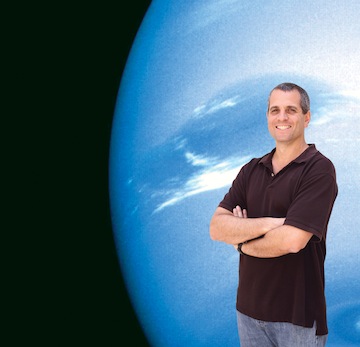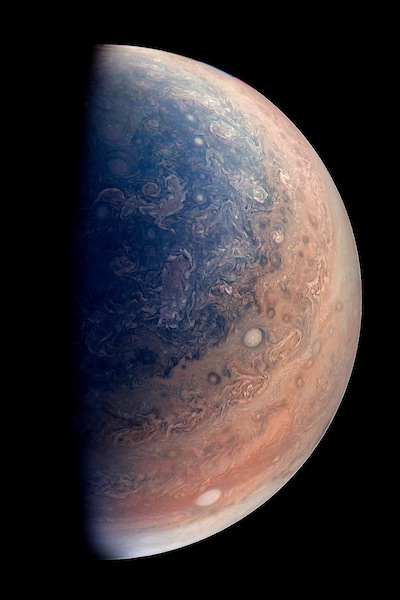This JunoCam image highlights Oval BA. (photo from nasa.gov)
The U.S. National Aeronautics and Space Administration (NASA) recently released the first findings of the Juno research spacecraft, which entered Jupiter’s atmosphere last year.
The Weizmann Institute of Science’s Dr. Yohai Kaspi is a senior member of the Juno mission team. The reason why this research is so important, he said, is because it will allow us to better understand how the solar system was formed.
“To do that, we really need to understand Jupiter and how it was formed because, then, we can understand earth, in sequence,” said Kaspi.

For Kaspi, the fascination with space came at the early age of 7, when his dad shared some pictures of the Voyager I and II and took him stargazing. His interest grew from there, including when he was navigating in the Negev while in the Israel Defence Forces.
“My hobby growing up was competitive sailing,” said Kaspi. “That drew my interest into meteorology and understanding why the wind blows the way it does. Growing up in Nahariya, which borders Lebanon … all kinds of stuff [are] coming from Lebanon – currents, trash. It was very obvious where the wind or current was coming from and that connected to sailing.”
Kaspi studied math and physics at Hebrew University before heading to the United States, seeking adventure and a doctorate at Massachusetts Institute of Technology. Soon after, he was recruited to be a professor at the Weizmann Institute of Science.
While at MIT, Kaspi became connected to the Juno mission, developing instruments to help measure atmospheric conditions on Jupiter.
“I was interested in space and the weather,” said Kaspi. “I studied meteorology, as it kind of brings them together … [with] planetary science. We have planets, which resemble earth in some aspects, but we don’t understand their features and circulation.”
While Jupiter is by far the biggest planet in the solar system (11 times the diameter of earth) and has the greatest mass (300 times that of earth), it is a gas planet (i.e. it has no liquid or solid parts). Kaspi has studied Jupiter’s different weather zones and deltas.
“I developed a theory for understanding how deeply they extend,” said Kaspi. “When you look at Jupiter, you have this red and white belt, or zone. That’s all at the cloud level, so it condensates at the same temperature. But, we have no information what’s happening underneath them. What we needed was a global way to survey what was happening underneath the cloud layer. And that’s exactly what Juno is.
“During my PhD, I developed a new method to relate between the gravity field of the planet and the flows underneath this cloud layer. To understand Jupiter, we need to understand what’s happening in its interior.”
Kaspi has been involved with Juno since 2008, along with 30 to 40 other scientists who form the core of the mission, developing and designing the experiments, and interpreting the data.

“We’re trying to deduce the depths of the flows from the gravity measurements of the planet,” explained Kaspi. “The purpose is to see what’s happening inside the planet. It has nine instruments and each one probes in different ways what is happening in the planet’s interior.
“One is a gravity instrument…. We send a beam from the spacecraft to earth. The beam travels 800 million kilometres and reaches earth. A desert in California captures that beam.
“We try to see the accelerations and decelerations of the spacecraft around the planet … trying to understand … the flow field and the gravity field of Jupiter.”
It was only when we first saw earth from space that we were able to understand the changing atmospheric conditions that are part of what is largely considered part of climate change, said Kaspi.
“We’d be able to understand how the solar system was formed, including earth,” he said of one of the project’s possible results. “For example, it’s really important for us to know if there’s a core inside Jupiter. A planet with a big or small core would have a different effect on the gravity field. When we measure the gravity field, we can deduce what’s happening deep inside the planet, which would lead us to different theories of how the solar system was formed.
“The connection to earth is we see the objects of Jupiter’s atmospheres … we don’t understand their strengths, how wide they are and how deep they are. We don’t have theories for that. If you want to have a good understanding of objects on earth, you have to look at the sister planet.”
The data-collecting portion of the Juno mission will come to a close at the end of this year. After 10 years of research and six orbits, the data will be analyzed to determine the direction of the mission going forward.
“We have already a lot of good data and we’re reaching a point where we can have significant results for understanding the structure, depths and composition of the atmosphere, but it’s a process,” said Kaspi. “Basically, we have one measurement every 53 days. So, every 53 days, I get my stuff and go to the U.S. and stay there for a week, analyzing the data and analyzing it for the rest of the 45 days, and then go back.”
Regardless of the results, Kaspi will continue the work he is doing at the Weizmann Institute on climate change and working on an instrument that will be sent to Jupiter on board the 2022 spacecraft being built by the European Space Agency.
“It will be the first Israeli instrument that will go beyond earth’s orbit,” said Kaspi. “That’s exciting. So, we’re involved in that and a variety of projects, trying to achieve fundamental understanding.”
As far as space exploration for the purpose of finding another planet fit for human dwelling, Kaspi said, “I’m just going to say that, if there is life in the solar system, it might be in the moons of Jupiter … because they have liquid water, a deep ocean, tens to hundreds of kilometres deep. Maybe there is life there.”
The public can follow the Juno mission on Facebook at facebook.com/nasajuno.
Rebeca Kuropatwa is a Winnipeg freelance writer.

